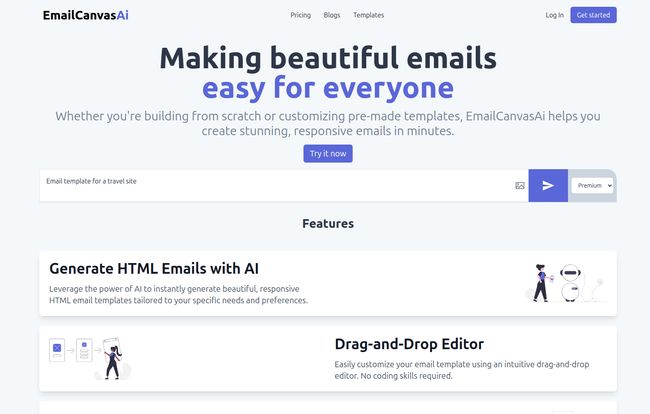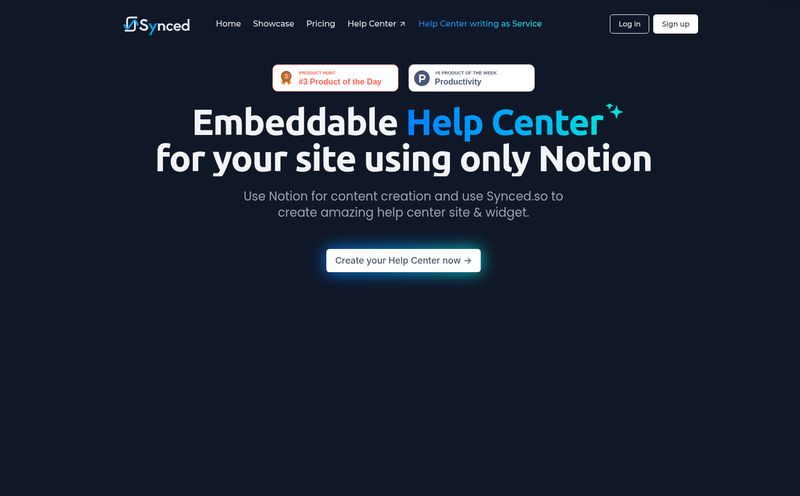Building HTML emails can be a special kind of nightmare. For years, it’s been this weird, dark art that exists in a time capsule from 2005. You slave away crafting a beautiful design, and it looks perfect. Then you test it in Outlook. And it looks like a Picasso painting after a spin in the tumble dryer. We’ve all been there, right? The endless `<table>` nesting, the inline CSS, the desperate prayers to the email client gods.
So, when a new wave of AI-powered email builders started cropping up, my interest was piqued. But so was my skepticism. Most of them are either too simple, offering all the creative freedom of a paint-by-numbers kit, or they produce code so bloated it makes my browser weep. Then I stumbled upon a tool called EmailCanvasAi. The name is a bit on the nose, sure, but the promise was intriguing: an AI generator with a drag-and-drop editor that also supports clean code with MJML. Could this be the one? The tool that finally bridges the gap between the no-code crowd and the code-is-law folks? I had to find out.
So, What Exactly Is EmailCanvasAi?
At its heart, EmailCanvasAi is an AI-powered platform designed to generate responsive HTML emails. You give it a prompt—something like “a promotional email for a summer shoe sale”—and its AI gets to work, whipping up a template for you. But that’s just the starting pistol. Where it gets interesting is what comes next.
It’s not just an AI prompt box. It's a full-fledged workshop. You get a user-friendly drag-and-drop editor that feels intuitive if you’ve ever used a modern website builder. You can pull in sections, swap out images, and change text without ever looking at a line of code. But then—and this is the part that made me lean in closer—it has a full code editor, import/export functions, and native support for MJML. That’s not something you see every day.

Visit EmailCanvasAi
The Features That Actually Matter
A features list on a homepage is one thing; how those features work in the real world is another. I took a spin through the platform to see what stood out from the usual marketing fluff.
The AI Generator: Your New (Slightly Eccentric) Intern
The AI generation is the main draw. The ability to just upload a picture of a design you like and have the AI try to replicate it as an email template is, I admit, pretty magical. It feels a bit like science fiction. For generating initial ideas or quick mockups, it’s fantastic. It’s like having a junior designer who’s incredibly fast but needs a little adult supervision.
You can’t just blindly trust the AI to nail your brand’s nuanced voice or complex layouts. You’ll still need to go in and tweak things. But as a way to blast through that initial “blank page” paralysis? It’s a genuine time-saver.
Drag-and-Drop for the Masses
The visual editor is clean and straightforward. It does what it says on the tin. If you’re a marketer, a startup founder, or anyone who wears multiple hats, this is your zone. You can build a professional-looking campaign without phoning a developer friend in a panic. It's responsive out of the box, which solves probably 80% of the headaches associated with email design. It lowers the barrier to entry, and I'm always a fan of that.
A Hat-Tip to the Coders: MJML and Code Control
Okay, this is the part I geeked out about. For the uninitiated, MJML (Mailjet Markup Language) is a markup language that makes developing responsive emails way, way easier. It abstracts away the nightmarish table-based layouts into simple, reusable components. The fact that EmailCanvasAi supports it is a massive green flag.
This means a developer can use the AI to generate a baseline template in clean MJML, pop open the code editor for fine-tuning, and then export the compiled HTML. You can even import your own existing code to use the editor. This flexibility is what separates it from the pack. It doesn't lock you into its ecosystem. It’s a tool, not a jail. According to Litmus, personalization and automation are key trends, and having this level of code control allows for much deeper integration with those systems.
Let's Talk About the Price Tag
Alright, the all-important question: what’s this gonna cost me? EmailCanvasAi runs on a subscription model based on tokens. And this is where you need to pay attention.
Here's a quick breakdown of their plans:
| Plan | Price | Tokens | Key Features |
|---|---|---|---|
| Free | Free | 1 per month | Standard AI, all editor features, image-to-template. |
| Starter | $15/month | 250 per month | Everything in Free + Premium AI model. |
| Pro | $40/month | 1,000 per month | Everything in Starter + Remove EmailCanvasAi branding. |
| Premium | $99/month | 3,000 per month | Everything in Pro + Premium Support. |
A crucial note: The Standard AI model uses 1 token per request, but the Premium AI model (available on paid plans) uses 10 tokens per request. So the 250 tokens on the Starter plan gets you 25 premium AI generations. The Free plan is really just a test drive—one token means one AI-generated email per month. It's enough to see if you like it, but not enough for real work.
My take? The Pro plan at $40/month feels like the sweet spot for small businesses and freelancers. You get a decent number of tokens and, most importantly, you can remove their branding, which is a must for professional use.
Who Is This Really For?
I see this tool fitting a few different profiles:
- Small Business Owners & Marketers: This is a godsend. You can create high-quality, responsive campaigns without a dedicated designer or developer on staff. It’s fast, efficient, and the results look great.
- Digital Agencies: A fantastic tool for rapid prototyping. You can quickly generate a few different concepts for a client, get approval on a design, and then either export the code for further customization or use it as is.
- Email Developers: Don't dismiss this as just a “no-code” toy. Use the AI to spit out a boilerplate MJML structure, saving you that initial setup time. Then you can dive into the code and work your magic. It's a workflow accelerator.
The Final Verdict: My Honest Thoughts
So, is EmailCanvasAi the holy grail of email creation? No, of course not. No single tool is. The token-based system will be a turn-off for some high-volume users, and you still need a good human eye to check the AI's work. You can't just set it and forget it.
But it's one of the most interesting and well-balanced email tools I've seen in a while. It successfully walks the tightrope between being accessible for beginners and powerful for professionals. That's a hard trick to pull off. It respects that some people want to drag-and-drop, and others want to get their hands dirty with code, and it builds a space where both can work.
For me, that’s its biggest win. It’s not just another AI email builder; it's a thoughtful email creation platform. If you've been fighting the email battle, it’s definitely worth using your one free token to see what it can do. Just use it wisely.
Frequently Asked Questions
- Is EmailCanvasAi free to use?
- Yes, there is a free plan. It gives you 1 token per month, which is enough to generate one email with the standard AI model and test out all the editor's features. It's best for trying out the platform before committing.
- Do I need to know how to code to use EmailCanvasAi?
- Not at all. The drag-and-drop editor is designed for users with no coding experience. You can create, customize, and export a complete HTML email without writing a single line of code.
- What is MJML and why is it important?
- MJML is a markup language that simplifies the process of creating responsive emails. It uses simple components that compile down to complex, battle-tested HTML tables, ensuring your email looks good across different email clients like Gmail and Outlook.
- How does the token system work?
- You spend tokens each time you ask the AI to generate an email. A request using the Standard AI model costs 1 token, while a request using the more advanced Premium AI model costs 10 tokens. Your monthly plan determines how many tokens you get.
- Can I use the emails I create with services like Mailchimp or HubSpot?
- Absolutely. EmailCanvasAi allows you to export the final, clean HTML code with one click. You can then take that code and paste it directly into any email service provider (ESP) that supports custom HTML templates.
- Can I import my own HTML code?
- Yes. The platform allows you to import existing email code, which is a great feature if you want to update an old template or use the editor to make quick changes to your own work.
Reference and Sources
- EmailCanvasAi Official Website
- EmailCanvasAi Pricing Page
- MJML - The Responsive Email Framework
- Litmus: Email Marketing Trends & Stats



